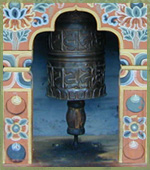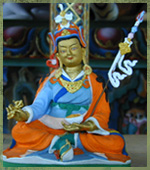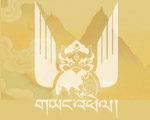|

In
Bhutan the relationship between religion and the arts is extremely
intimate. No artistic expression can be separated from its
religious significance. This may be exhibited both directly,
through the making of items used directly for religious purposes,
and indirectly through the motivations involved in the production
process. In many respects artistic heights are associated
with spiritual achievement. Many of the most eminent religious
figures through Bhutanese history were also renowned for their
artistic talents. Pema Lingpa was an accomplished painter,
sculptor and architect, and was raised by a family of blacksmiths.
The Shabdrung was gifted in painting and sculpting. The great
15th Century bridge-builder Thangtong Gyalpo is revered as
an important saint.
 Artistic
forms used directly for religious purposes include temples,
dzongs, chortens and mani walls, thangkas, wall paintings
and images, and numerous ritual objects. Paintings and sculptures
are consecrated in a special ceremony, whereby they come to
personify the deities they depict. Such works are produced
through support from all strata of society. The royal family,
nobility and clergy continue to provide very significant patronage.
The commission of a work of art is seen as a pious act that
will earn great merit. The ubiquity of the arts in Bhutan
alludes to the importance of Buddhism in everyday life and
the intensity of faith. Artistic
forms used directly for religious purposes include temples,
dzongs, chortens and mani walls, thangkas, wall paintings
and images, and numerous ritual objects. Paintings and sculptures
are consecrated in a special ceremony, whereby they come to
personify the deities they depict. Such works are produced
through support from all strata of society. The royal family,
nobility and clergy continue to provide very significant patronage.
The commission of a work of art is seen as a pious act that
will earn great merit. The ubiquity of the arts in Bhutan
alludes to the importance of Buddhism in everyday life and
the intensity of faith.
Buddhist art serves a very different purpose from other art
forms, being concerned with highlighting certain important
values associated with spiritual experience. The role of the
artist is therefore to transmit such teaching through their
art. The iconographical conventions are thus very strict,
and artistic freedom may only be expressed in minor background
details. Each deity is viewed as having particular special
attributes that cannot be changed without altering the meaning
and religious function. Such a design places emphasis on traditional
wisdom over and above novelty and innovation.
|



